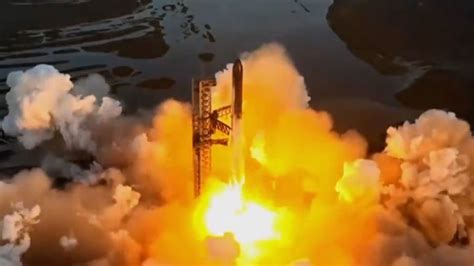
SpaceX’s Starship, the most powerful rocket ever built, experienced a dramatic failure during its fourth integrated test flight on Thursday, with Elon Musk wryly characterizing the event as a “Rapid Unscheduled Disassembly!” after the booster stage exploded over the Gulf of Mexico and the Starship itself, while achieving a soft landing in the Indian Ocean, experienced a far harder splashdown than anticipated.
The highly anticipated test aimed to achieve controlled landings of both the Super Heavy booster and the Starship spacecraft, marking a significant step towards SpaceX’s ambition of creating a fully reusable transportation system for missions to the Moon, Mars, and beyond. While the overall mission demonstrated substantial progress compared to previous attempts, the explosive demise of the booster and the rough landing of the Starship highlighted the inherent challenges of developing such complex and innovative technology.
SpaceX confirmed that the Super Heavy booster experienced an engine failure and subsequent explosion during its return to Earth. “Super Heavy experienced an engine issue during its boostback burn, ultimately leading to a rapid unscheduled disassembly,” the company stated. Despite this setback, the booster successfully executed its flip maneuver and reignited a significant number of its engines before the anomaly occurred.
The Starship spacecraft itself fared somewhat better, completing a controlled descent through the atmosphere and successfully reigniting its engines for the landing burn. However, telemetry data indicated that the landing was far from nominal. “Starship made a controlled entry and soft landing in the Indian Ocean,” SpaceX reported. However, later observations indicated a much harder landing than anticipated, potentially causing significant damage to the vehicle, although specific details are still being assessed.
The fourth test flight incorporated several upgrades and modifications based on lessons learned from previous attempts. These included improved heat shielding, enhanced engine control algorithms, and refined guidance systems. The goal was to increase the probability of successfully executing the landing maneuvers and gathering critical data on the performance of the vehicles under extreme conditions.
Despite the mixed results, SpaceX executives expressed optimism about the overall progress of the Starship program. “Each flight test provides invaluable data that helps us rapidly iterate and improve the design,” said a SpaceX spokesperson. “We are confident that we are on the right path to achieving our goals of creating a fully reusable space transportation system.”
The development of Starship is crucial to NASA’s Artemis program, which aims to return humans to the Moon by 2026. A variant of the Starship spacecraft has been selected as the Human Landing System for the Artemis III mission, and its successful operation is essential for the program’s success. The ongoing test flights are critical for validating the design and operational capabilities of the Starship and ensuring its readiness for crewed missions.
The “Rapid Unscheduled Disassembly” of the booster and the less-than-ideal landing of the Starship underscore the high-risk, high-reward nature of space exploration and the iterative development process required to push the boundaries of technology. SpaceX remains committed to its ambitious goals and plans to continue conducting test flights to refine the Starship design and achieve its full potential. The company is currently analyzing the data from the fourth flight test to identify the root causes of the anomalies and implement corrective actions for future missions.
Detailed Breakdown:
Super Heavy Booster Anomaly:
The Super Heavy booster’s failure during the boostback burn is a significant setback, but it also provides valuable insights into the challenges of controlling such a massive and powerful vehicle. The booster is equipped with 33 Raptor engines, which generate over 16 million pounds of thrust – more than any other rocket ever flown. Coordinating the operation of these engines and maintaining stability during the boostback maneuver is an incredibly complex task.
The “engine issue” cited by SpaceX could refer to a variety of potential problems, including engine failure, fuel system anomalies, or control system malfunctions. The company’s engineers will be meticulously analyzing telemetry data and wreckage debris to determine the precise cause of the failure and identify any design flaws or operational procedures that need to be addressed. The boostback burn is critical for returning the booster to the launch site for reuse, and its successful execution is essential for achieving the overall goal of a fully reusable launch system.
Starship Landing Challenges:
While the Starship spacecraft successfully completed its descent and landing burn, the “hard” landing in the Indian Ocean raises concerns about the vehicle’s structural integrity and the effectiveness of its landing systems. The Starship is designed to withstand the extreme heat and aerodynamic forces of atmospheric reentry, and its engines are capable of performing precise landing maneuvers. However, the landing process is inherently challenging, and even slight deviations from the planned trajectory can lead to significant problems.
The hard landing could have been caused by a variety of factors, including errors in the guidance system, engine malfunctions, or unexpected aerodynamic conditions. The company will be evaluating the extent of the damage to the vehicle and determining whether any design changes are necessary to improve its landing performance. The ability to achieve controlled and precise landings is crucial for the Starship’s long-term viability, as it will enable the vehicle to be reused multiple times, significantly reducing the cost of space transportation.
Impact on Artemis Program:
The ongoing development challenges with Starship have implications for NASA’s Artemis program, which relies on the Starship Human Landing System (HLS) to transport astronauts to the lunar surface. Any delays or setbacks in the Starship program could potentially impact the Artemis timeline and jeopardize the goal of returning humans to the Moon by 2026. NASA is closely monitoring the progress of the Starship development program and working closely with SpaceX to mitigate any potential risks. The agency has emphasized the importance of rigorous testing and validation to ensure the safety and reliability of the Starship HLS.
NASA Administrator Bill Nelson has expressed confidence in SpaceX’s ability to overcome the challenges and deliver a successful lunar landing system. However, he has also acknowledged the inherent risks of space exploration and the need for careful planning and execution. The success of the Artemis program hinges on the successful development of the Starship HLS, and NASA is committed to providing the necessary support and resources to ensure its success.
SpaceX’s Iterative Approach:
SpaceX’s approach to developing Starship is characterized by rapid iteration and a willingness to learn from failures. The company conducts frequent test flights, even at the risk of vehicle loss, to gather data and refine the design. This iterative approach has been instrumental in the success of SpaceX’s other launch vehicles, such as the Falcon 9 and Falcon Heavy. By quickly identifying and addressing problems, SpaceX is able to accelerate the development process and achieve ambitious goals.
The “Rapid Unscheduled Disassembly” of the booster and the hard landing of the Starship are viewed as learning opportunities, rather than insurmountable setbacks. SpaceX engineers are meticulously analyzing the data from the fourth flight test to understand the root causes of the anomalies and implement corrective actions for future missions. The company is committed to continuing its test flight program until the Starship achieves its full potential.
Future Outlook:
Despite the challenges, the Starship program remains on track to revolutionize space transportation. The vehicle’s massive payload capacity and full reusability have the potential to significantly reduce the cost of access to space, opening up new opportunities for scientific research, commercial ventures, and human exploration. SpaceX plans to continue conducting test flights of the Starship in the coming months, gradually increasing the complexity of the missions and pushing the boundaries of the technology.
The company is also working on developing the infrastructure necessary to support regular Starship operations, including launch pads, landing sites, and propellant production facilities. SpaceX’s ultimate goal is to create a self-sustaining human presence on Mars, and the Starship is the key to achieving that ambitious vision. The development of the Starship is a long-term endeavor, and there will inevitably be setbacks and challenges along the way. However, SpaceX’s commitment to innovation and its willingness to learn from failures make it well-positioned to overcome these obstacles and achieve its ultimate goals.
Musk’s Perspective:
Elon Musk’s three-word summary of the booster’s fate – “Rapid Unscheduled Disassembly!” – reflects his characteristic blend of technical understanding and wry humor. It acknowledges the failure while also emphasizing the iterative nature of the development process. Musk has consistently maintained that failures are an inevitable part of innovation and that they provide valuable learning opportunities. He has also emphasized the importance of maintaining a sense of humor in the face of adversity. Musk’s leadership style has been instrumental in fostering a culture of innovation and risk-taking at SpaceX, which has enabled the company to achieve its ambitious goals. His ability to communicate complex technical information in a clear and engaging manner has also been crucial to building public support for the Starship program.
Engineering Challenges and Solutions:
The development of Starship involves overcoming numerous engineering challenges, including:
- Heat Shielding: The Starship must withstand extreme temperatures during atmospheric reentry. SpaceX has developed a heat shield made of hexagonal tiles that are designed to absorb and radiate heat. The design and performance of this heat shield are critical for the success of the Starship program. Improvements to the heat shield were implemented for this flight and appeared to perform well.
- Engine Technology: The Raptor engines are a key innovation that enables the Starship to achieve its performance goals. These engines are powered by liquid methane and liquid oxygen, and they are designed to be highly efficient and reusable.
- Guidance and Control Systems: The Starship requires sophisticated guidance and control systems to navigate through the atmosphere and perform precise landing maneuvers. These systems must be highly accurate and reliable to ensure the safety of the vehicle and its passengers. Improvements in this area were cited as specific changes that contributed to the relative success of this flight compared to previous attempts.
- Structural Integrity: The Starship must be strong enough to withstand the stresses of launch, reentry, and landing. SpaceX has used advanced materials and manufacturing techniques to ensure the structural integrity of the vehicle.
SpaceX engineers are constantly working to improve these systems and overcome the challenges of developing a fully reusable space transportation system. The company’s iterative approach, coupled with its commitment to innovation, is driving rapid progress in these areas.
Reusable Technology and Cost Reduction:
The full reusability of the Starship is a key factor in its potential to revolutionize space transportation. By reusing the booster and spacecraft multiple times, SpaceX can significantly reduce the cost of access to space. This could open up new opportunities for scientific research, commercial ventures, and human exploration.
The Falcon 9 rocket, which is partially reusable, has already demonstrated the cost-saving benefits of reusability. SpaceX estimates that reusing the Falcon 9 booster saves tens of millions of dollars per launch. The Starship, with its full reusability, has the potential to achieve even greater cost reductions.
Global Implications of Starship:
The successful development of the Starship would have significant global implications:
- Scientific Research: Lower launch costs would enable more frequent and ambitious scientific missions, leading to new discoveries about the universe and our place in it.
- Commercial Opportunities: The Starship could be used to deploy large constellations of satellites, enabling global internet access and other commercial services.
- Human Exploration: The Starship could transport humans to the Moon, Mars, and beyond, opening up new frontiers for exploration and settlement.
- Planetary Defense: The Starship could be used to deflect asteroids that pose a threat to Earth.
The Starship has the potential to transform our relationship with space and unlock new possibilities for human civilization.
Conclusion:
While the fourth test flight of Starship resulted in a “Rapid Unscheduled Disassembly” of the Super Heavy booster and a harder-than-anticipated landing of the Starship itself, it also demonstrated significant progress in the development of this revolutionary space transportation system. SpaceX’s iterative approach, coupled with its commitment to innovation, is driving rapid progress towards the goal of creating a fully reusable and affordable launch vehicle. The development of Starship is crucial for NASA’s Artemis program and has the potential to transform our relationship with space, opening up new opportunities for scientific research, commercial ventures, and human exploration. The data obtained from this test flight will be invaluable as SpaceX continues to refine the design and operational procedures for future Starship missions. The path to full reusability and reliable space travel is paved with both successes and setbacks, and SpaceX’s ability to learn from these experiences will ultimately determine the success of the Starship program. The future of space exploration may well depend on the ongoing evolution of this ambitious and groundbreaking project.
Frequently Asked Questions (FAQ):
1. What does Elon Musk mean by “Rapid Unscheduled Disassembly!”?
This is a somewhat humorous, though technically accurate, way of describing an explosion. In engineering terms, it indicates that a component, in this case, the Super Heavy booster, broke apart rapidly and unexpectedly. It’s a euphemism used in the aerospace industry to acknowledge a failure without dwelling on the negative aspects and emphasize the ongoing development process.
2. What were the main objectives of this fourth Starship test flight?
The primary objectives were to achieve controlled landings of both the Super Heavy booster and the Starship spacecraft. This included successfully executing the boostback burn and landing burn for the booster, as well as a controlled reentry and soft landing in the ocean for Starship. Other key objectives were to gather data on the performance of the heat shield, engines, and guidance systems under extreme conditions.
3. How does the outcome of this test flight affect NASA’s Artemis program?
The Artemis program relies on a variant of the Starship spacecraft as the Human Landing System (HLS) to transport astronauts to the lunar surface. While the recent test flight experienced issues, the progress made is still valuable to NASA. The success of the Artemis program depends on the reliable performance of Starship, and SpaceX’s iterative testing process is crucial for identifying and addressing any potential problems before crewed missions. NASA is closely monitoring SpaceX’s progress and working collaboratively to ensure the success of the Artemis program.
4. What are the next steps for SpaceX after this test flight?
SpaceX will be conducting a thorough analysis of the data collected during the fourth test flight to identify the root causes of the Super Heavy booster’s explosion and the Starship’s hard landing. Based on this analysis, they will implement design modifications and operational procedure adjustments for future test flights. Further test flights are planned to continue refining the Starship design and improving its reliability. The specific timeline for these future flights will depend on the findings of the data analysis and the implementation of necessary changes.
5. How is SpaceX’s approach to Starship development different from traditional aerospace development?
SpaceX employs an iterative development process characterized by frequent test flights and a willingness to learn from failures. This approach contrasts with traditional aerospace development, which often involves extensive ground testing and simulations before conducting limited flight tests. SpaceX’s rapid iteration allows them to quickly identify and address design flaws, accelerate the development process, and achieve ambitious goals. While this approach involves a higher risk of vehicle loss, it also enables faster progress and innovation.









